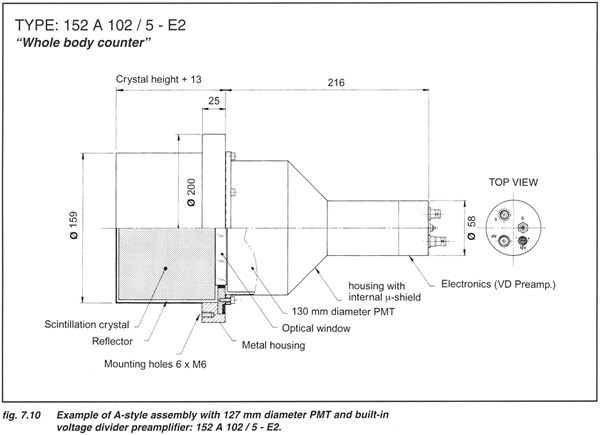 |
Detectors with photomultiplier tubes exist basically in two versions: a demountable version called A-style and an integrated one called B-style. Assemblies with integrated photomultiplier tubes: B-styles FEATURES Scintillation detectors with integrated photomultiplier tube(s) consist of a scintillation crystal, coupled directly to a photomultiplier tube with a slightly flexible, high refractive index optical coupling medium. The crystal and PMT are hermetically sealed (gas tight) in a lighttight housing with an aluminium or beryllium entrance window. Detectors have an internal m-magnetic shielding or a solid m-metal housing (special option) around the PMT and can be supplied as plug-in units to connect to a Voltage Divider (VD) or with a built-in VD (see section 8). The advantages of this construction are :
APPLICATION One of the most widely used scintillation detectors world-wide is the 76 x 76 mm NaI(Tl) detector (SCIONIX type 76 B 76 / 3) which is the scintillation detector standard for general gamma spectroscopy having excellent efficiency and energy resolution. For low background (LB) applications, B-style assemblies can be supplied in low background steel or electrolytic copper housings. All detector components can be selected on their lowest possible radioactive background. In LB units, quartz or undoped NaI light guides are used to reduce the background from the PMT (see section 5.7). On the next pages some standard B-style detectors are presented as well as an example of an assembly equipped with an axial well (BP-style). Beside the above shown, many other PMT diameters are possible. Standard PMT diameters are : 13, 19, 25, 28, 38, 51,76, 90, and 127 mm.. |
|||||||||||
| BACK TO TOP | |||||||||||
| Thin window B-style assemblies : BA-, BDand
BM-styles FEATURES For the detection of low energy radiation, thin scintillation crystals are combined with PMTs in a thinwindow assembly. For the detection of X-rays > 10 keV, 30 mm thick Aluminum windows (BA-styles) are used. For lower energies, the BD-style with a 0.2 or 0.3 mm thick Be window is the detector of choice. BM is the notation for a thin mylar entrance window for the detection of heavy ions or low energy b-particles with non-hygroscopic crystals. The thickness of the above materials is not fixed and can be modified to your application. NOTE Thin window B-style assemblies are often constructed with light guides to compensate for local inhomogeneities in the response of the photocathode of the PMT |
|||||||||||
 |
|||||||||||
 |
|||||||||||
 |
|||||||||||
 |
|||||||||||
 |
|||||||||||
 |
|||||||||||
 |
|||||||||||
| BACK TO TOP | |||||||||||
Assemblies with demountable photomultiplier tubes: A-styles Detectors with more than one PMT are often constructed as demountable assemblies. The advantage is that in case of break-down of one PMT, it can be replaced easily by the user without having to take apart the entire crystal assembly. Especially for complicated detectors such as Anti-Compton shields or large whole body counters, this is the normal approach. A-styles are also available with axial well (AP-style) or thin entrance window (AA-styles). |
|||||||||||
| BACK TO TOP | |||||||||||